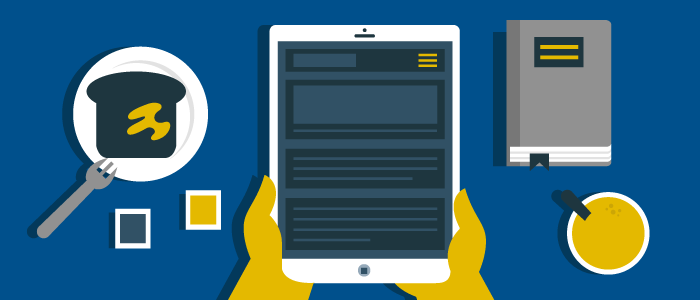
Have you ever thought about digital magazine history? Magazines were originally invented in the 15th century, shortly after the invention of the Gutenberg press. Magazines were different from books because they featured different authors arranged around a single topic or some other central theme and were periodic, published at a regular weekly, monthly, or quarterly frequency.

Digital Magazine History, Starting with PDFs
Magazines remained much the same as printed matter for centuries. However, formats evolved from being mainly text-based to being full of splashy photography and graphics as four-color printing became cheap and readily available to publishers worldwide. With the dawn of desktop publishing in the 1980s, every magazine publisher could create a digital PDF magazine simply by selecting that output format as they stored their desktop publishing files.
This advancement in digital magazine history did not result in any immediate change in the industry since there was still no easy and cheap way to distribute those digital PDF magazines.
With the dawn of the consumer Internet in the 1990s, email and the web presented an easy and cheap way to distribute a PDF or a digital PDF magazine. I can recall many publishers deciding to distribute their controlled circulation or free magazine as a download from their website or something they would send out as an attachment to an email. The ubiquitous PDF format made these new magazines easy to read on any device as long as the user had access to a PDF reader that most devices carried as part of their original software complement.
While the distribution of these magazines may have been substantial, the initial economic impact was negligible since most publishers did not attempt to charge their sponsors for the additional distribution generated by the PDF versions of their magazine.
[text_ad]

When PDFs Became Digital Apps
With the release of the first iPad in 2010, a new digital magazine format quickly appeared that we would call the digital app magazine.
Unsurprisingly, one of the first software platforms to spread widely was generated by Adobe, called the Adobe Digital Publishing Suite. There were also dozens of other digital app magazine software platforms that would enable a publisher to take their magazine and turn it into an app suitable for consumption on an iPad and soon on the iPhone and other digital devices. These new platforms included new functionality that allowed the publisher to charge for subscriptions and manage distribution and entitlement for their issues and subscriptions. This led to the ability to generate subscription revenue and charge sponsors for digital distribution since that distribution could now be documented. Still, most publishers chose to give away that distribution to sponsors as a bonus tied to their print editions.

Digital Magazine History Evolving into HTML Web Editions
In 2014, Prime Publishing and Mequoda Systems launched the first HTML web magazine called I Like Crochet. The magazine was linear, finite, periodic, and displayed all the characteristics of a magazine regardless of platform. The magazine was embedded into a larger website that included other content formats, including free downloadable patterns as an audience development incentive and custom collections of patterns re-purposed from the magazine and acquired as additional premium content.
The Haven WordPress system that powered this new HTML web magazine could process premium subscriptions via credit card and gate access. Only premium subscribers could gain full access to the entire magazine issue and magazine back issue library.
The value proposition for I Like Crochet was greatly enhanced by the evergreen nature of the crochet patterns that are their minimum information unit. Prime and Mequoda would later discover that not only evergreen content such as knitting patterns, recipes, or other types of instructional content would be suitable for this type of HTML web magazine, but that news content and other feature content could be archived and then made available as special collections around particular theme or topic.
The web is now home to hundreds of HTML web magazines, including the dozens that we’ve helped launch over the past seven years. I Like Crochet has grown to have more than 18,000 premium subscribers and is financially successful as a standalone digital magazine with no print counterpart. Its success has caused us to launch additional properties around the topics of knitting, cooking, and gardening during the ensuing years using the same digital HTML web magazine format and business model.
Other examples of digital HTML web magazines that don’t use our platform include Fine Woodworking, Cooks Illustrated, TIME, Scientific American, Harvard Business Review, and The Atlantic. Visit any of those links to get a glimpse at their web editions and digital archives.
In addition to I Like Crochet above, examples of digital HTML web magazines that use the Haven WordPress platform include:
1. Food Gardening Network, our newest digital magazine publishing system. Food Gardening Network represents a from-scratch start-up where all content is digital. The website features five editorial frameworks that include search engine optimized daily tips, gardening freebies that act as audience development incentives, a monthly digital magazine, a digital collections library that features book-length, in-depth reference-style resources on three new topics per month, and a digital cookbook which will be added to the system later this year. The system also demonstrates the current state-of-the-art for the Haven WordPress digital publishing and marketing software platform which is shared by more than a dozen independent publishers.
2. Financial Freedom Federation, launched at the height of the pandemic in 2020. Users are introduced to the brand as free Bronze members where they receive free daily financial tips, access to numerous financial guidebooks, and free premium content previews. The Gold level includes the Federation’s digital magazine, more than 30 premium special reports, and carefully curated Investor Briefings. Financial Freedom Federation demonstrates how multiple member benefits can be transformed into a powerful marketing pyramid.
3. The Yankee digital publishing and marketing system is anchored by one of the travel industry’s most successful audience development portals, NewEngland.com. Website visitors are offered free guides and free newsletters, giving them an insider’s view of the New England lifestyle. The system uses our unique Special Collection and Content Preview marketing program to allow unpaid members to sample premium Yankee content, including their digital magazine, Travel Library, and Special Collections plus their award-winning PBS television series, Weekends with Yankee.
4. I Like Knitting was launched as a companion to I Like Crochet Network in 2015 and demonstrates how business models, software platforms, and business processes can be leveraged to efficiently serve a second audience niche that is closely related to its older sibling. Historically, we’ve used this strategy to launch nine companion digital publishing and marketing systems in the arts and crafts field, dramatically reducing the development and operating costs for the second and subsequent systems. The close relationship between the two crafting websites also allows test ideas that are successful for one of the two siblings to be quickly leveraged by the other.
5. RecipeLion Magazine leverages the massive power of the Prime Food Network to build a free member database using our proprietary onboarding and welcome programs. Free members gain limited access to a vast digital media library of magazines, cookbooks, and television shows with regular offers to upgrade to full unlimited access with a Gold Club membership.
To help demonstrate the success of these various publishers, we have created a new 90-minute case study framework to help you understand how our systems and methods can be used to help you create a successful digital publishing and marketing system for your publication. If you’re interested in having us guide you through either of these case studies, please schedule a 90-minute consultation with us today.

Digital Web Magazine Success Metrics
Over the past seven years, we’ve discovered that retention rates for our web magazines are similar to what we’ve seen for print magazines over time because we have several engagement programs for premium subscribers that increase the value proposition.
Our premium subscribers typically receive three preview emails per week plus a weekly summary that gives them access and insight into current and past premium content. During any given month, more than 80% of the page use we generate on any of our digital HTML web magazines is not for the most recent magazine issue, but for content from past issues and even more specifically from the collections around themes with content gathered from those past issues.
While digital HTML web magazines are similar in many ways to their print ancestors, they do offer the opportunity for much higher levels of engagement using email as a way to bring readers back to the premium content several times per week.
This higher level of engagement translates into higher retention rates and higher lifetime subscription value. We’ve also discovered that the multiplatform nature of a web magazine, which includes issues, collections, previews, and a daily newsletter, all create a value proposition that allows us to charge consumers an average of $50 per year.
We believe that all magazines will evolve towards this format over the following decades. By the year 2050, we believe digital magazine history will show that the magazine publishing industry is entirely digital and clean.
What more would you add to the history of magazines and digital magazine history?
[text_ad]



Interés article.
I just came across an old publication that I was part of in 1988/89.
It was published by Rochester Institute of Technology by students and we were told at the time that they believed it was the first magazine that was published using 100% digital technology (even digital cameras).
I’m curious what you might know about that.
Thanks.
I’m sorry to say I don’t have any knowledge around that particular implementation of digital magazines.